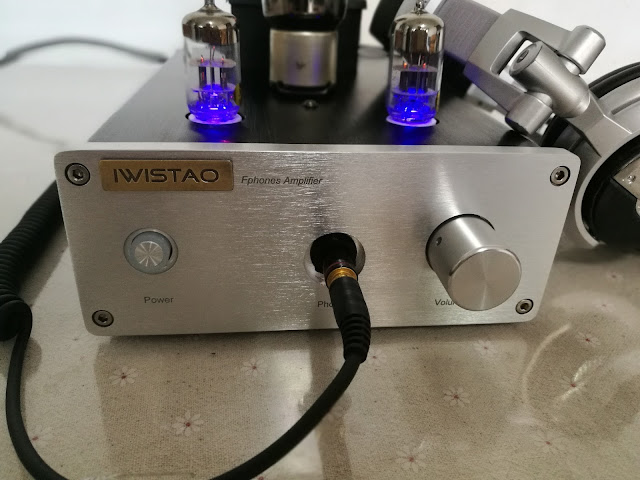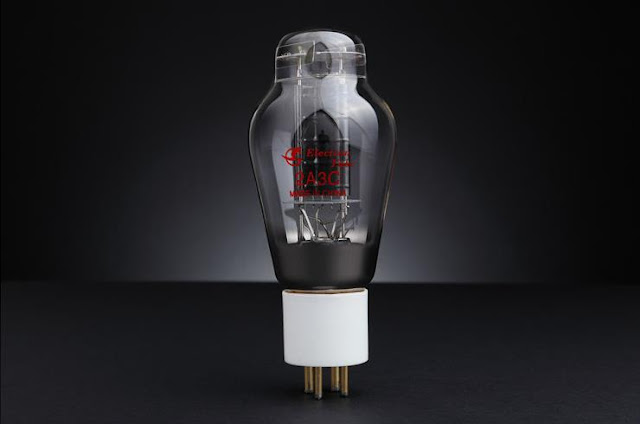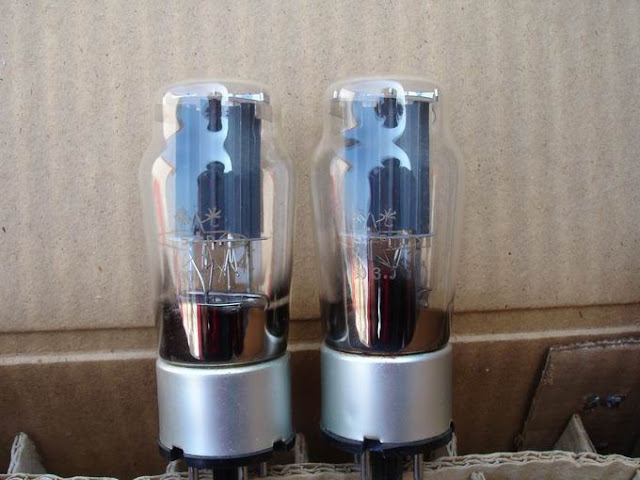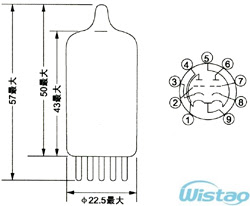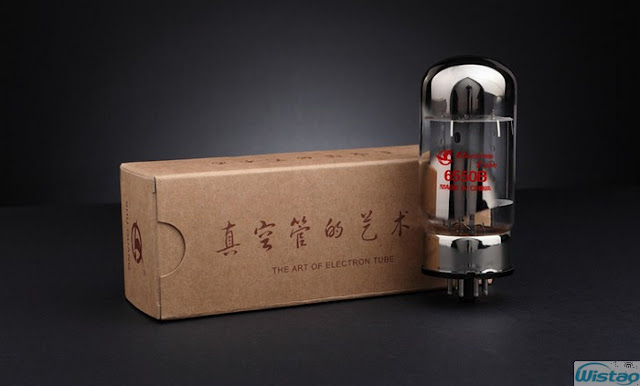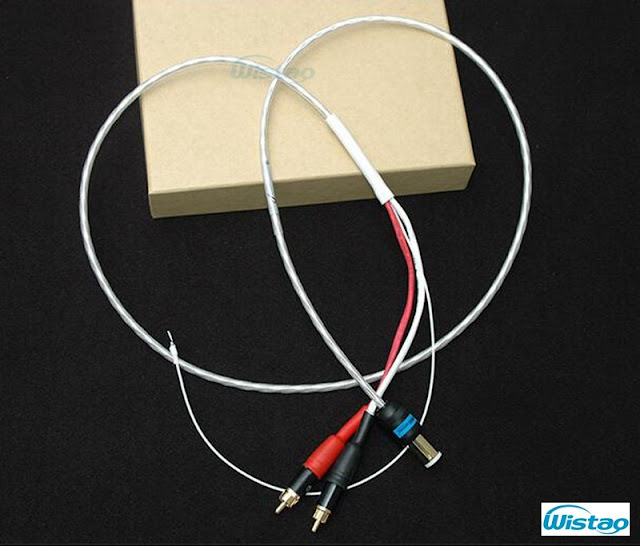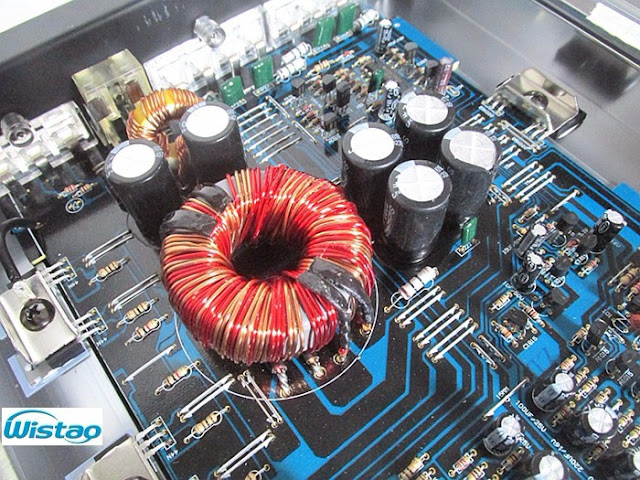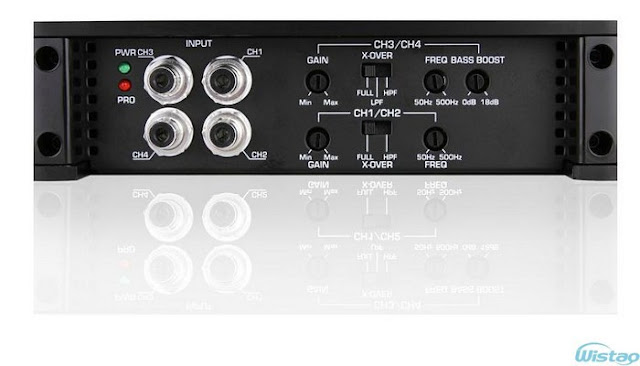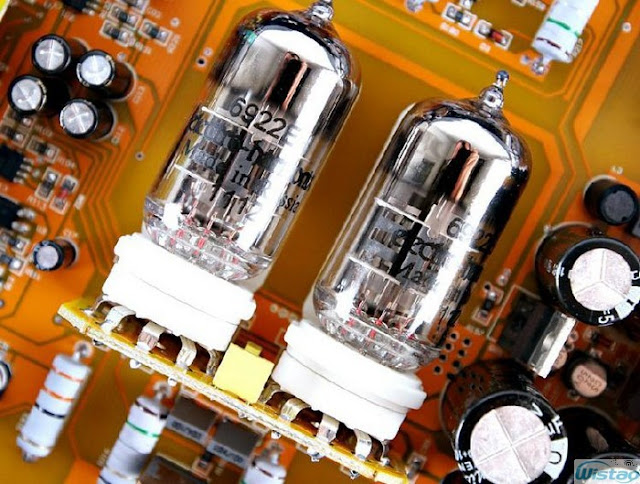Brief of Vacuum Tube Models and Replacement
The blog collects some tube models and give them a brief, also you can do a simple replacement, but for details, you need search them and get detailed parameters and curve.
2A3–power triode, used in single-ended hi-fi amps. Still made in China. Old stock American and European versions are very scarce and expensive.
2A3 SINGLE-PLATE–original version of this audio triode, made by RCA in 1931 and by a few other firms.Very scarce. Single-plate versions are very difficult to make, a high-cost version is currently being marketed by KR Enterprise.
2C39A–UHF power triode, old type–still made by Eimac, and old stock versions are available.
3-500Z–power triode used in amateur-radio amplifiers. Popular, but getting expensive. No longer made by Triton ETD (USA) made in China.
3C33–power triode–see 6528.
3CPX800A7–air-cooled power triode, special pulse-rated version of 3CX800A7.
Still made by Eimac.
3CPX5000A7–air-cooled power triode. Still made by Eimac.
3CW5000H3–water-cooled power triode–still made by Eimac.
3CW40,000H3–water-cooled power triode. Still made by Eimac.
3CX400A7–air-cooled power triode, popular in amateur equipment–see 8874
3CX400U7–air-cooled power triode–still made by Eimac.
3CX800A7–air-cooled power triode–popular amateur-radio tube. Still made by Eimac, soon to be made by Svetlana.
3CX1200A7–air-cooled power triode–Still made by Eimac
.
3CX1200D7–air-cooled power triode–Still made by Eimac.
3CX1200Z7–air-cooled power triode–Still made by Eimac.
3CX1500A7–air-cooled power triode, popular in amateur-radio amplifiers–see 8877
3CX3000A1–air-cooled power triode–Still made by Eimac.
3CX3000F1–air-cooled power triode–Still made by Eimac.
3CX4500F3–air-cooled power triode used in industrial heating–see YU108.
3CX10,000U7–air-cooled power triode–Still made by Eimac.
3CX20,000C7–air-cooled power triode. Still made by Eimac.
4-65A–power tetrode used in RF amplifiers. Stll made in China.
4-400A–power tetrode used in RF amplifiers. Still made in China.
4-1000A–power tetrode used in RF amplifiers. Still made in China.
4CS250R–conduction-cooled power tetrode. Still made by Eimac.
4CV50,000E–large vapor-cooled power tetrode. Still made by Eimac.
4CV100,000C–large vapor-cooled power tetrode. Still made by Eimac.
4CV250,000B–large vapor-cooled power tetrode. Still made by Eimac.
4CX300A–air-cooled power tetrode. Still made by Eimac.
4CX300Y–air-cooled power tetrode. Still made by Eimac.
4CX350R–power tetrode–Still made by Eimac. Also known as 8930.
4CX600JB–power tetrode–Still made by Eimac and Svetlana.
4CX1000A–air-cooled power tetrode. Still made by Eimac
.
4CX1000K–air-cooled power tetrode. See 4CX1000A.
4CX1500B–air-cooled power tetrode. Still made by Eimac. SED (C Logo) makes
4CX1500A, which is a different type and notplug-in compatible.
4CX3000A–air-cooled power tetrode. Still made by Eimac.
4CX20,000D–air-cooled power tetrode. Still made by Eimac.
4CX35,000C–air-cooled power tetrode. Still made by Eimac.
4PR60A–power tetrode used in pulse-power applications. Still made by Triton ETD.
UX-201A–antique-radio triode, also known as 01A or 301A. Increasingly scarce, not being manufactured, no easy substitute.
5AR4–rectifier, widely used in hi-fi and guitar amps. Chinese, Russian and JJ versions available.
5R4–rectifier, seen in some old amps. All versions (G, GA, GY etc.) out of production, though old stock is still available.
5U4–rectifier, seen in some old amps. Still made in Russia.
5V4–rectifier, seen in some older hi-fi and guitar amps. Still made in Russia and China.
5Y3–rectifier, seen in some older hi-fi and guitar amps. Still made in Russia and China.
5Z4–rectifier, seen in old radios. Out of production, though old stock is still available.
6A3–power triode, used in single-ended hi-fi amps. Scarce and expensive, out of production.
6A5–power triode, similar to 6A3. Special type with sleeves over the filaments to decrease hum. See 6A3.
6AM6–also called EF91–small RF pentode. Out of production, though old stock is still available.
6AN8–small triode-pentode, used in the old Dynaco Mark 3 amplifier and a few others. Out of production, though old stock is still available. A 6GH8, 6U8 or similar can be substituted, by changing the pin connections–suggest contacting an experienced technician.
6AQ5–a small power pentode, also called 6005. Often seen in small amplifiers from 1950s. Out of production, though old stock is still available.
6AS7–a power triode for power supplies and hi-fi amplifiers. 6AS7 will electrically replace the 6080, which is no longer made. Some equipment does not have room for 6AS7s, as they are physically much larger than 6080s.
6BG6–old TV sweep tube, used in some early hi-fi amps. Still made in Russia by Ulyanov. There are many similar sweep tubes, such as the 6CD6 and 6DQ6. Retrofitting equipment to accept the 6BG6 is recommended.
6BK4–beam triode used as a high-voltage regulator. Out of production.
6BQ5–small power pentode. Also called EL84. Very popular in smaller guitar amps, such as the classic Vox AC-30 which the Beatles used. Also popular in hi-fi. Still made in Russia (2 versions), Serbia and China. SED (C logo) sells the SV83,
which is similar to the EL84 except for a lower screen-grid rating of 200 volts.
6BM8—triode-pentode, originally for hi-fi and TV use. Still being made by SED (C logo) in Russia.
6BQ7–small preamp dual triode used in radio equipment. Out of production, though old stock is still available.
6C4–small preamp triode used in early hi-fi equipment. Out of production, though old stock is still available.
6C19–a small power triode used in high-end amplifiers. Made in Russia by Ulyanov.
6C33CB–a big power triode used in high-end amplifiers. Made in Russia by Ulyanov.6CA7–a beam tetrode for guitar amps and hi-fi amps. It is a plug-in replacement for the EL34, but is more rugged. (It sounds quite different from the EL34 and some people prefer the 6CA7.). Suggest having amp modified to accept 6550.
6CD6–TV sweep tube. No longer in production. (See 6BG6)
6CG7–a medium-power dual triode. Often found in hi-fi amplifiers made by Audio Research. A version is being made by the Ei factory in Serbia.
6CL6–small power tube, sometimes seen in older audio equipment. Out of production, old stock is still available.
6CW4–Nuvistor tube, used in old FM tuners and some hi-fi and pro audio. Nuvistors are scarce and unlikely to be made in the near future.
6CW5–small power pentode, also called EL86. Occasionally used in older hi-fi amps and radios. Still made in Serbia by Ei.
6DJ8–small preamp tube, widely used in modern hi-fi amps and preamps. Also known as premium types 6922, 7308.A 6922 is still made by JJ in Serbia and in Russia and sold by Sovtek.
6DL5–same as EL95. Small power pentode for audio. Out of production.
6DN7–TV oscillator tube, used in some hi-fi equipment. Out of production.
6DQ6–TV sweep tube–Out of production. (See 6BG6)
6E5–Tuning indicator tube or “eye” tube, used in old radios. Old versions are getting scarce. All eye tubes are believed to be out of production at this time. Suggest using a 1629 and adapter available from Antique Electronic Supply.
6EA7–see 6EM7.
6EJ4–beam triode, high-voltage shunt regulator. Out of production. See 6BK4.
6EJ7–small pentode, used in Futterman hi-fi amps. Out of production.
6EM7–TV oscillator tube, used in some hi-fi equipment. Out of production.
6EU7–small preamp dual triode, used in some older guitar amps. One made at the Reflector factory in Russia is available. Also suggest modifying equipment to accept 12AX7 instead, which is very similar.
6EY6–beam power tetrode, originally used in TV sets. Out of production. Guitar-amp parts dealers have been marketing this as a replacement for 6V6GT. Sounds different from 6V6GT types, using it is up to the consumer. It will work, but uses much more filament current and will load down the power transformer in a 6V6 guitar amp. (see 6V6GT)
6EZ5–beam power tetrode, originally used in TV sets. Out of production. Guitar-amp parts dealers have been marketing this as a replacement for 6V6GT. Sounds different from 6V6GT types, using it is up to the consumer. It will work, but uses much more filament current and will load down the power transformer in a 6V6 guitar amp. (see 6V6GT)
6F6–power pentode, widely used in old radios. Out of production. Suggest retrofitting with 6V6GT.
6FQ7–version of 6CG7, direct plug-in replacement for it. (see 6CG7)
6FS7–medium-power pentode, used in Futterman hi-fi amps. Out of production.
6GH8A–small triode-pentode, used in older hi-fi amps and other equipment. Old stock is still easy to find. (Note: there are many plug-in replacements for 6GH8–they include 6U8, 6KD8, 6AU8 and others. Consult a tube manual for more
substitutes.)
6GL7–see 6EM7.
6GM5–version of 7591 with different basing–see 7591.
6GW8–power pentode with high-mu triode, also called ECL86. Out of production. 6BM8 made by Svetlana is similar except for pinout, suggest converting amp to accept 6BM8.
6HU8–dual pentode, used in old Fisher hi-fi amps. Long out of production. Unique, very scarce and expensive–no easy replacement for it. European number is ELL80. Suggest retrofit to accept 6BQ5/EL84–this requires considerable modification andthe services of an experienced technician.
6J5, 6J5GT–preamp triode, used in audio–has underground audiophile following. Out of production.
6JK6–small pentode, used in Marantz 10B tuner. Out of production, very scarce. Other types, such as the 6688, may be usable if the equipment is modified.
6JE6–see 6JS6.
6JS6–large TV “sweep” tube, used in audio, CB and amateur radio amplifiers. Out of production. Scarce and expensive, as are all large American sweep tubes. Suggest modifying the amp to accept SED (C logo) EL509 or EI EL519–requires new socket and rewiring,might require modification to bias circuits.
6KD6–large TV “sweep” tube, used in audio, CB and amateur radio amplifiers. Out of production. Scarce and expensive, as are all large American sweep tubes. Suggest modifying the amp to accept SED (C logo) EL509 or EI EL519–requires new socket and rewiring, might require modification to bias circuits.
6KG6–TV sweep tube–still made in Russia by SED (C logo). (see EL509)
6L6GC–beam tetrode, very popular in guitar amps, rarely used in hi-fi. Many versions are still made in Russia, China and Slovakia. Groove Tubes is in production of a GE clone of this tube.
6L6WGB–supposed to be a super-premium 6L6GB for military use. Most old American versions were identical to 5881. Current Chinese-made tube under this name is good-quality but physically different from original. Some old-stock American WGBs are available on the surplus market.
6LF6–large TV “sweep” tube, used in audio, CB and amateur radio amplifiers. Out of production. Scarce and expensive, as are all large American sweep tubes. Suggest modifying the amp to accept SED (C logo) EL509 or EI EL519–requires new socket and rewiring, might require modification to bias circuits.
6N1P–unusual Russian dual triode, similar to a 6BQ7 with larger cathodes and different internal construction. Usable as a plug-in replacement in some 6DJ8/6922 applications. Made in Russia, sold by SED (C logo).
6S19P–see 6C19
6SJ7–small preamp pentode, octal base. Used in older audio equipment and some modern hi-fi. One made at the Voskhod factory in Kaluga, Russia is available, along with old-stock versions.
6SL7GT–small preamp dual triode, high gain, octal base. Used in pre-1956 hi-fis and guitar amps, and in a few modern amps. One made at the Voskhod factory in Kaluga, Russia is available, along with old-stock versions.
6SN7GT–small preamp dual triode, medium gain, octal base. Used in older hi-fi and some modern hi-fi. Now made by Sovtek and at the Voskhod factory in Kaluga, Russia, along with old-stock versions.
6T5–tuning-eye tube, rare collector’s item–can be replaced with 6E5. Out of production. 6T5 has a different glow pattern from 6E5 and other types, making it collectible.
6U5–tuning-eye tube, see 6E5.
6U8A–triode-pentode–see 6GH8.
6V6GT–small beam power tetrode, used in popular guitar amps. A Chinese JJ, and Sovtek versions available.
6X4–small rectifier tube, used in older hi-fi. Out of production.10–old power triode, also known as 210 or 801A. It has an underground following with audiophiles. Out of production. It is scarce and getting expensive, demand is very low.
12AT7–a common preamp dual triode. Still in production in Yugoslavia by Chinese, Ei, JJ and Sovtek.
12AU7–a common preamp dual triode. Still in production in Yugoslavia by Chinese, Ei, JJ and Sovtek.
12AX7–the most common audio preamp dual triode. The old Telefunken smooth-plate ECC83 is the most popular style (especially in hi-fi), it is scarce and expensive. Chinese version back in production. Still made in Slovakia (JJ), Serbia (Ei), and Russia (Sovtek). Groove Tubes now offers a Mullard version of the 12AX7 (supposedly made in China).
12AY7–a special low-noise dual triode for audio equipment. Out of production, old stock is available. GE 6072A is probably the best. There is no other exact replacement, although the 5751 can substitute in some equipment. (see 6072)
12BH7–a medium-power dual triode, often seen in pro-audio equipment. A version is being made in Serbia at the Ei factory. Old stock is also still available in the surplus market.
12BY7–a small pentode used in the Harman-Kardon Citation II amplifier, in Collins transceivers and in old TV equipment. Out of production. Svetlana SV83 MIGHT be usable–considerable (!) modification is required. Suggest talking to a specialist.
12DW7–a small dual triode used in a few older guitar and hi-fi amps. A version is made by the Ei factory in Serbia.
12X4–see 6X4.
13CW4–Nuvistor tube, used as a retrofit in some studio microphones. Out of production. See 6CW4.
16BM8–version of 6BM8 with unusual heater voltage–used in Russian series-string TV sets, made in Russia by SED (C logo).
20LF6–see 6LF6
25E5–small TV sweep tube, sometimes used in Japanese hi-fi receivers of the 1960s. Out of production. Suggest having equipment modified to accept 6L6GCs instead. This is a considerable modification and requires the services of an
experienced technician.
27LF6–see 6LF6
42–power pentode, widely used in old radios. Out of production. Suggest changing socket to allow use of 6V6GT if absolutely necessary–this may decrease the value of a classic radio.
45–small power triode, widely used in old radios and sometimes used in single-ended hi-fi amplifiers. Out of production. Old ones are getting scarce. There is no direct replacement; military version VT-52 is even scarcer. (Warning: at least one tube distributor is selling Chinese 2A3s and labeling them as 45s–this will NOT work–the 2A3 requires much more filament power than a 45, and could damage the power transformer.)
50–power triode, sometimes seen in old radios and in single-ended hi-fi amplifiers. There is no direct replacement (the 10 is similar but not recommended). Suggest the Cetron 50, which is expensive but is the only one still in production. SE amplifiers can be modified to accept 300Bs by changing the filament supply to 5 volts.
80–rectifier tube, widely used in old radios. Out of production. Suggest changing socket to allow use of 5Y3 if absolutely necessary–this may decrease the value of a classic radio.
83–mercury-vapor rectifier tube, used in old radios and a few early Fender guitar amps. Do not use 5Y3, damage may result. Out of production.
101–old audio triode, also called 101A, B, C, etc…. Audiophile cult item, especially in Japan. Out of production, no easy substitute.
205–old audio triode, also called 205A, B, C or D. Sometimes called “tennis ball tube”. Out of production. Audiophile cult item, especially in Japan. No easy substitute, although Svetlana SV811-3 or SV572-3 could be used by changing sockets and providing 6.3v at 4 amps for filament.
210–see 10
211–old audio power triode, used in modern single-ended hi-fi amps. Chinese version is inexpensive, some people have qualityissues with it. Old stock is expensive.
212E–old audio power triode, also called 212A, B, C or D. Audiophile cult item, especially in Japan. Very large glass tube. Otherwise out of production.
252A–power triode, audiophile cult item especially in Japan. Out of production. Original version is scarce and sells for $800-up.Suggest using 300B, which is a very similar plug-in replacement. (see 300B)
275A–power triode, audiophile cult item especially in Japan. Out of production. Original version is scarce and sells for $250-up.
The 300B may be substituted by adjusting the bias voltage and the plate loading.
300A–earlier version of 300B, electrically identical–see 300B
300B–power triode, very popular with audiophiles in hi-fi amps. Almost always used in single-ended circuit. Made by Westrex (USA), Richardson/Cetron (USA), China (3 mfrs), Russia (SED C logo) and Reflector/Sovtek), and East Europe (KR
Enterprise,AVVT, JJ).
417A–small preamp triode, very low noise–underground popularity with audiophiles. Out of production, old stock is easy to find.Same as 5842.
801A–see 10
805–old audio power triode, used in old radio transmitters and some single-ended hi-fi amps. Old stock is expensive, $150 ormore. Still made in China.
807–beam power tetrode, often used in older radio equipment and some early hi-fi. Uprated version of 6L6GC with plate cap. Chinese version is being made.
809–old audio power triode, used in World War II equipment. Not in production. Suggest retrofitting with 811A or 812A.
810–old audio power triode, used in old radio transmitters. Chinese version is inexpensive. Old stock is expensive, $200 or more.
812–see 812A
812A–old power triode, used in older transmitters and ultrasonic cleaning equipment. Made in China and Russia (Ryazan and SED C logo).
813–transmitting beam-power tetrode. Still made in Russia by Ulyanov and in China.
829–transmitting beam-power tetrode. Still made in Russia by Ulyanov and in China.
832–transmitting beam-power tetrode. Still made in Russia by Ulyanov and in China.
845–old audio power triode, used in modern single-ended hi-fi amps. Chinese version is inexpensive, higher-cost Richardson/Cetron version is still being made. Old stock is very expensive.
1614–premium version of metal-cased 6L6, originally the standard tube in the McIntosh MC-30 hi-fi amplifier. Scarce, out of production. Suggest using 6L6GC.
5687–dual triode computer tube, has an underground audiophile following. Out of production. 6900 and 7044 are plug-in replacements. Used in Audio Note hi-fi equipment. Old stock is easy to find.
5691–special rugged version of 6SL7, used in MFA Luminescence hi-fi preamp–very scarce, out of production–see 6SL7.
5692–special rugged version of 6SN7, used in underground audiophile equipment–very scarce, out of production–see 6SN7.
5751–dual triode used in Conrad-Johnson preamps, has a small audiophile following. Out of production, old stock is easy to find. Sovtek now makes one.
5763–small beam-power tetrode, used in 1950s radio equipment. Out of production, scarce and expensive. Suggest retrofitting equipment with 6BQ5/EL84.
5842–low-noise triode, used in RF and underground audiophile equipment–see 417A.
5881–beam power tube, version of 6L6GB–popular in older guitar amps. A version is made in Russia by Reflector/Sovtek.
5930–special rugged 2A3–Out of production, scarce and expensive–see 2A3.
5931–special rugged 5U4–Out of production, scarce and expensive–suggest using Russian 5U4G.
5932–special rugged 6L6–Out of production, scarce and expensive–suggest using 6L6GC.
5963–special dual triode used in early computers–has underground audiophile following. Out of production, use 12AU7 instead.
5965–see 5963.
6072A–super-quality version of the 12AY7. See 12AY7.
6080–rugged industrial version of 6AS7–physically smaller. Out of production. SED 6AS7 is suggested as substitute, though it may not fit into some equipment made for 6080. (see 6AS7)
6094–small beam-power tetrode, used in military equipment–underground audiophile following. Out of production. Old stock is sometimes available.
6146–beam power tube, popular in older radio transmitters and found in some audio amps. Chinese version is available from distributors. If quality is an issue, old stock may be available.
6201–special high-reliability version of 12AT7–see 12AT7.
6267–same as EF86–still made in Russia by SED (C logo).
6336–power triode, used in power supplies and some modern hi-fi amplifiers. It was used in an amplifier made by Italian firm Graaf.There is no direct equivalent. Out of production, scarce and expensive. Suggest replacing with 6AS7 if possible–consult with experienced service technician or equipment manufacturer.
6360–small power tetrode used in radio equipment. Still made in Russia at Ulyanov factory, under number GU-17.
6384–beam-power tetrode, used in military equipment–underground audiophile following. Out of production.
6528–power triode, used in power supplies–underground audiophile following. There is no direct equivalent, and it is not in production. Old stock is difficult to find but may be available. Suggest replacing with 6AS7 if possible–consult with experienced service technician or equipment manufacturer.
6550–beam tetrode, popular in hi-fi and bass-guitar amps. Original made by Tung-Sol, all American versions out of production. Still made in China and Russia (SED C logo, Sovtek).
6550A–slightly uprated version of 6550, 42 watts dissipation instead of 35 watts. Made by GE and Sylvania in 1970s and 1980s. SED C logo SV6550C will work in place of all 6550A types. 6550B, B-2, B-3–older SED 6550 types–obsolete and out of production. See SV6550C.
6688–small pentode, low noise, used in radio equipment. Out of production, readily available as old stock. Rarely used by audiophiles in homebrew amps.
6696–large water-air-cooled power triode–not in production–suggest retrofit with another type.
6697–large air-cooled power triode–not in production–suggest retrofit with another type.
6900–super version of 5687–see 5687. Out of production.
6922–premium 6DJ8–see 6DJ8 Versions currently made by JJ, Sovtek, and Ei.
6973–small beam-power tetrode, originally made by RCA, used rarely in older hi-fi and pro audio equipment. Out of production, scarce and expensive. Sovtek is now producing a 6973 (2005)
7025–special low-hum 12AX7–see 12AX7. A Chinese 7025 is being offered by Magic Parts. (2005)
7027–beam power tube, similar to 6L6GC. Ampeg used these in guitar amps made in the 1960s and 1970s. JJ now makes a new 7027A. Old versions are scarce. May be substituted by good-quality 6L6GC, or by 6550 if heater power supply is upgraded.
7044–dual triode, used in RF equipment and in homebrew hi-fi–see 5687
7189–small beam power tetrode, often used in older hi-fi. Out of production. 6BQ5/EL84 is exact plug-in replacement, although older amps apply excessive voltage. If 6BQ5s are used in an amp that specifies 7189s, the plate and screen
voltages should be reduced. Consult with an experienced technician. (see 6BQ5)
7199–small triode-pentode, used in the old Dynaco Stereo-70 amplifier and many others. A version is made at the Reflector plant in Russia, which is available from audio tube dealers. A 6GH8 or 6U8 type can be substituted, by changing the pin connections–suggest contacting an experienced technician.
7241–power triode–see 6528.
7242–power triode–see 6528.
7247–special high-reliability version of 12DW7–see 12DW7. Currently being made by Ei.
7308–premium 6DJ8, guaranteed low noise and low hum–see 6DJ8.
7355–small beam power tetrode–used in a few old hi-fi amps. Out of production, scarce and expensive.
7408–premium version of 6V6GT–see 6V6GT.
7581, 7581A–beam power tube, uprated version of 6L6GC and sometimes given as replacement for KT66. Out of production. Original 7581 made by GE is rare and expensive. It can easily be recognized by its flesh-colored base. There is a 1980s military-surplus version made by Philips/Sylvania which is currently available from distributors.
7586–Nuvistor tube, used in some pro-audio equipment–see 6CW4.
7591–small beam power tetrode, common in old hi-fi and some guitar amps. 7591 was popular in early 1960s. NOS is getting expensive. Sovtek now makes a direct replacement, the 7591EH. It is about 3/16″ larger in diameter than the original 7591A, but works fine. There is no easy substitute, the 7868 and 6GM5 are electrically identical but have different bases–they are also scarce and expensive. Suggest contacting audio tube dealers, if they don’t have any then the amp must be converted to 6L6GCs (this is a considerable modification, it will give less output power). Note: JJ is manufacturing the 7591S, which is the same size and diameter of the original 7591A. (2005)
7763–beam-deflection modulator tube, often used in early SSB radio equipment. Out of production, scarce. Suggest modifying equipment to accept easier-to-get beam-deflection tubes, such as 6AR8.
7788–ultra-high-transconductance pentode, used in RF and audio preamps, has underground audiophile following–see 6688.
7868–small beam power tetrode, common in old hi-fi and some guitar amps. Very popular in early 1960s, Sovtek now makes a 7868. (2005)
7895–Nuvistor tube, used in Ampex MR-70 tape recorder and other pro-audio equipment. Out of production. See 6CW4.
8068–a glass beam power tetrode used in high-voltage power supplies, and sometimes in “homebrew” hi-fi amplifiers. It is a very special tube, capable of operating at up to 3500 volts. Out of production, scarce and expensive. No easy substitute.
8072–ceramic power tetrode–currently out of production. See 8874.
8106–small pentode, used in mobile radio equipment. Equipment could be modified to accept 12BY7 or SV83. Suggest talking to an experienced technician.
8121–ceramic power tetrode–currently out of production. See 8874.
8122–matched pair of 8072–ceramic power tetrode–currently out of production. See 8874.
8156–small beam pentode, used in mobile radio equipment. Out of production. There is no easy substitute, EL509 or 6BG6 could be used with considerable equipment modification–suggest consulting with an experienced mobile-radio technician.
8417–a power beam tetrode used in hi-fi amplifiers. Out of production, scarce and expensive. The Sylvania version was the best, the GE had problems with grid overheating. Suggest having an experienced service tech modify the amp to accept 6550s. This requires rewiring the base and changing the bias circuitry to provide a more negative bias voltage. The amp will produce less power unless the driver stage is extensively modified. Consult an experienced technician.
8791V1–TV tetrode, made by Burle.
8792V1–TV tetrode, made by Burle.
8806–TV tetrode, made by Burle.
8807–TV tetrode, made by Burle.
8873–conduction-cooled tetrode, popular in amateur radio linear amps (Heathkit SB240)–made by Eimac. Suggest retrofit with different tube, such as SED (C logo) 4CX400A or 4CX800A. The 8874 can also be retrofitted (see 8874).
8874–air-cooled triode, popular in amateur radio linear amps–made by Eimac and SED (C logo). Same as 3CX400A7.
8875–air-cooled triode, popular in amateur radio linear amps (Dentron MLA2500)–made by Eimac.
8877–tetrode, popular in amateur-radio amplifiers–made by Eimac.
8916–ceramic UHF tetrode used in TV transmitters, made by Burle.
8930–see 4CX350R.
8950–power tetrode used in mobile radio equipment. Out of production, scarce and expensive. Suggest that the equipment be modified to accept EL509/519, this is an involved job requiring an experienced technician.
8975–see 8950
8961–see 3CX400U7.
8984–ceramic UHF tetrode used in TV transmitters, made by Burle.
9007–FM broadcast ceramic tetrode, made by Burle.
AC701–small preamp triode, used in studio microphones. Out of production, scarce and expensive.
BW1184–industrial heating triode–still made by EEV.
BW1185–industrial heating triode–still made by EEV.
E34L–version of EL34 made by Teslovak in Slovakia–gives slightly more peak power than standard EL34, otherwise similar.
E88CC–premium 6922–see 6DJ8
E188CC–super premium 6922 – long life and low noise
ECC81–European name for 12AT7. (see 12AT7)
ECC82–European name for 12AU7. (see 12AU7)
ECC83–European name for 12AX7. (see 12AX7)
ECC88–European name for 6DJ8. (see 6DJ8)
ECC803–premium European version of 12AX7. (see 12AX7)
ECL82–European name for 6BM8–still made in Russia by SED (C logo).
ECL86–see 6GW8.
EF86–small audio pentode, low noise–still made in Russia by SED (C logo). Also see 6267.
EL34–very popular power pentode used in guitar amps and hi-fi. Still made in Russia, Slovakia, Serbia and China.
EL36–beam power tetrode, TV sweep type, used in some older RF linear amplifiers. Also called 6CM5. No longer in production. Suggest modifying equipment to accept EL509/519.
EL37–beam power tube, uprated version of 6L6 type. No longer in production. Rare and valuable British tube, has a following among guitarists and audiophiles. Can be replaced with 6L6GC types if rebiasing is performed.
EL84–see 6BQ5.
EL84M–Russian-made version of EL84, good quality.
EL84N–previous name for power pentode now sold by SED (C logo) under name SV83. Has lower screen-grid voltage rating than conventional EL84. (see 6BQ5)
EL95–see 6DL5
EL509–TV sweep tube. Also called 6KG6. One of only two large sweep tubes still being made, 509 is made in Russia by SED (C logo). Serbian Ei version is called EL519, very similar.
EL519–TV sweep tube–made in Serbia by Ei factory. Plug-in replacement for EL509.
ELL80–see 6HU8.
EM1–tuning-indicator tube, European only. Out of production, scarce and expensive. Unique 4-bladed shadow pattern. Used in recent Magnum-Dynalab MD108 FM tuner, as well as old European radios.
EM80, 81, 84, 85, 87–tuning-eye indicator tubes. Not in production at this time.
EMM801–Tuning-indicator tube used in the old Dynaco FM-3 tuner. Out of
production and getting scarce.
GI-30–beam power tetrode, made in Russia by Ulyanov. Similar to 5894 and 829.
GM-70–power triode, made by Ulyanov in Russia. It has an underground audiophile following. Sockets are impossible to find, although an 832-type socket can be drilled out to accept the GM-70.
GM-100–giant glass audio power triode, made in Russia by Ryazan.
GS-36B–Russian designator for 4CX400A. Made in Russia by SED (C logo).
GU-13–see 813. Made in Russia by Ulyanov.
GU-17–miniature transmitting beam tetrode. Made in Russia by Ulyanov.
GU-19-1–transmitting beam tetrode. Made in Russia by Ulyanov.
GU-29–Russian designator for 829A. Made in Russia by Ulyanov.
GU-32–Russian designator for 832A. Made in Russia by Ulyanov.
GU-34B–VHF transmitting tetrode. Russian type, manufacturer unknown. Suggest contacting tube dealers in Europe for replacements.
GU-48–Russian designator for 833A. Made in Ukraine by Poljaron.
GU-50–VHF transmitting pentode, version of old WWII Telefunken LS50. Made in Russia by Ulyanov, used in a hi-fi amplifier by Manley Laboratories.
GU-70B–Russian designator for 4CX350A. Made in Russia by SED.
GU-74B–Russian designator for 4CX800A. Made in Russia by SED.
GU-91B–Russian designator for 4CX1600B. Made in Russia by SED.
KT61–beam power tube, similar to 6L6GC. Out of production. Valuable and rare old British tube. May be replaced with 6L6GC. Modification of the amplifier may be required, as the KT61 has higher transconductance and different bias requirements.
KT63–beam power tube, similar to 6L6GC. Out of production. Valuable and rare old British tube. May be replaced with 6L6GC. Modification of the amplifier may be required, as the KT63 has different bias requirements.
KT66–beam power tube, uprated replacement for 6L6 types. Was out of production, two different versions were recentlyintroduced by Golden Dragon and Groove Tubes.Valuable old British tube, expensive and scarce. May be replaced with 6L6GC. Modification of the amplifier may be required, as the KT66 has different bias requirements.
KT77–beam power tube, uprated replacement for EL34. Out of production. Valuable old British tube, expensive and scarce. May be replaced with a top-quality EL34 in some circuits, provided screen-grid ratings of EL34 are observed.
KT88–beam power tube, similar to uprated 6550. Original MOV/Genalex version is valuable old British tube, expensive and scarce. Still made in China, Russia and Slovakia.
KT90–beam power tube, used in modern hi-fi amplifiers. Unique KT88-like tube made by Ei factory in Serbia, available from audio-tube dealers.
KT99–version of KT90–see KT90.
KT100–Chinese version of KT90, available from Golden Dragon distributors. See KT90.
M2057–very similar to 8950. See 8950.
PL519–TV sweep tube with 40-volt heater, made in Serbia by Ei factory. Used in a few high-end amplifiers.
SV572–audio power triode series, made in Russia, sold by SED. Available in mu of 3, 10, 30, and 160.
SV811–audio power triode series, made in Russia, sold by SED. Available in mu of 3 or 10.
TH328–UHF-TV power triode–still made by Thomson.
TH347–UHF-TV power tetrode–still made by Thomson.
TH382–UHF-TV power tetrode–still made by Thomson.
TH563–UHF-TV power tetrode–still made by Thomson.
TH571–TV power tetrode–still made by Thomson.
TH582–UHF-TV power tetrode–still made by Thomson.
VF14–old German radio tube, used in studio microphones. One of the world’s scarcest tubes. A new one sells for $1500+. Owners of Neumann U47 microphones are told that only the VF14 is a good-sounding tube in their microphones. U47 owners must buy used tubes from specialist dealers. Suggest consulting an experienced technician.
Y442–water-cooled tetrode, made by Eimac and SED.
Y584A–power tetrode (AKA 4CPW10000A0–still made by EIMAC and SED.
Y644–special version of 4CX250BC–made by Eimac and SED.
YC108A–power tetrode–made by Eimac and SED.
YD1202–industrial heating triode—-still made by Eimac.
YU108–air-cooled power triode used in industrial heating, made by Eimac and SED.


